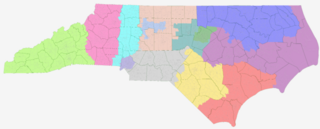 W
WOregon Ballot Measure 55 (2008) or House Joint Resolution (HJR) 31 was a legislatively referred constitutional amendment that was put before voters in 2008. This measure was designed to fix a situation where State Senators whose seats are not up in the next cycle following a redistricting are forced to move to their new district. It had no organized opposition. The measure appeared on the November 4, 2008 general election ballot in Oregon.
 W
WA California Congressional Redistricting Initiative, Proposition 20 was on the November 2, 2010 ballot in California. It was approved by 61.2% of voters. Election officials announced on May 5 that the proposition had collected sufficient signatures to qualify for the ballot. The measure is known by its supporters as the VOTERS FIRST Act for Congress.
 W
WMichigan Proposal 18-2 was a ballot initiative approved by voters in Michigan as part of the 2018 United States elections. The proposal was created in preparation of the 2020 United States Census, to move control of redistricting from the state legislature to an independent commission. The commission consists of thirteen members selected randomly by the secretary of state: four affiliated with Democrats, four affiliated with Republicans, and five independents. Any Michigan voter can apply to be a commissioner, as long as they have not been, in the last six years, a politician or lobbyist. Proponents argued that Michigan's current districts are gerrymandered, giving an unfair advantage to one political party. Opponents argued that the process would give the secretary of state too much power over redistricting, and that the people on the commission would be unlikely to understand principles of redistricting. The proposal was approved with 61.28% of the vote.
 W
WDave's Redistricting is an online web app created by Dave Bradlee that allows anyone to simulate redistricting a U.S. state's legislative districts.
 W
WThe Reapportionment Act of 1929 is a combined census and apportionment bill passed by the United States Congress on June 18, 1929, that establishes a permanent method for apportioning a constant 435 seats in the U.S. House of Representatives according to each census.
 W
WThe U.S. state of Arizona, in common with the other U.S. states, must redraw its congressional and legislative districts every ten years to reflect changes in the state and national populations. Redistricting normally follows the completion of the United States Census, which is carried out by the federal government in years that end in 0; the most recent Census took place in 2010. Historically, Arizona's legislature has had control over the redistricting process. However, Proposition 106, passed in 2000, delegated the power to draw congressional and legislative boundaries to a bipartisan independent commission. The Arizona Independent Redistricting Commission (AIRC) comprises two Democrats, two Republicans, and one independent chair. County and local redistricting, which normally takes place along the same timeline as congressional and legislative redistricting, is carried out by the individual county and local governments rather than the AIRC.
 W
WRedistricting in California has historically been highly controversial. Critics have accused legislators of attempting to protect themselves from competition by gerrymandering districts. Conflicts between the governor and the legislature during redistricting often have only been resolved by the courts.
 W
WRedistricting in North Carolina has been a controversial topic due to allegations and admissions of gerrymandering.
 W
WRedistricting in Pennsylvania refers to the decennial process of redrawing state and federal congressional districts in Pennsylvania.
 W
WRedistricting in Virginia has been a controversial topic due to allegations of gerrymandering. In the 2017 Virginia General Assembly, all of the redistricting reform bills were killed.
 W
WThe 2003 Texas redistricting refers to a controversial mid-decade state plan that defined new Congressional districts. In the 2004 elections, this redistricting supported the Republicans taking a majority of Texas's House seats for the first time since Reconstruction. Opponents challenged the plan in three suits, combined when the case went to the United States Supreme Court in League of United Latin American Citizens v. Perry (2006).
 W
WUnited States congressional apportionment is the process by which seats in the United States House of Representatives are distributed among the 50 states according to the most recent decennial census mandated by the United States Constitution. Each state is apportioned a number of seats which approximately corresponds to its share of the aggregate population of the 50 states. However, every state is constitutionally guaranteed at least one seat.